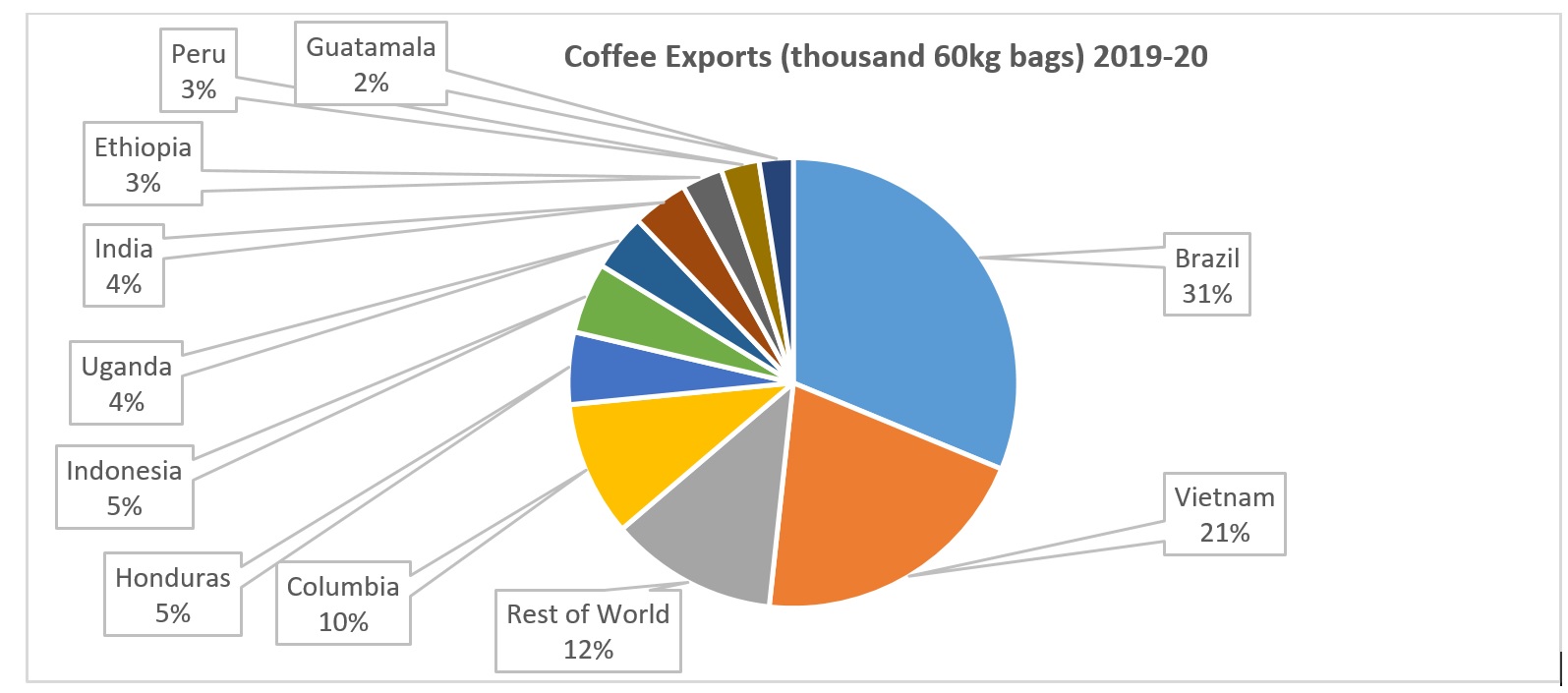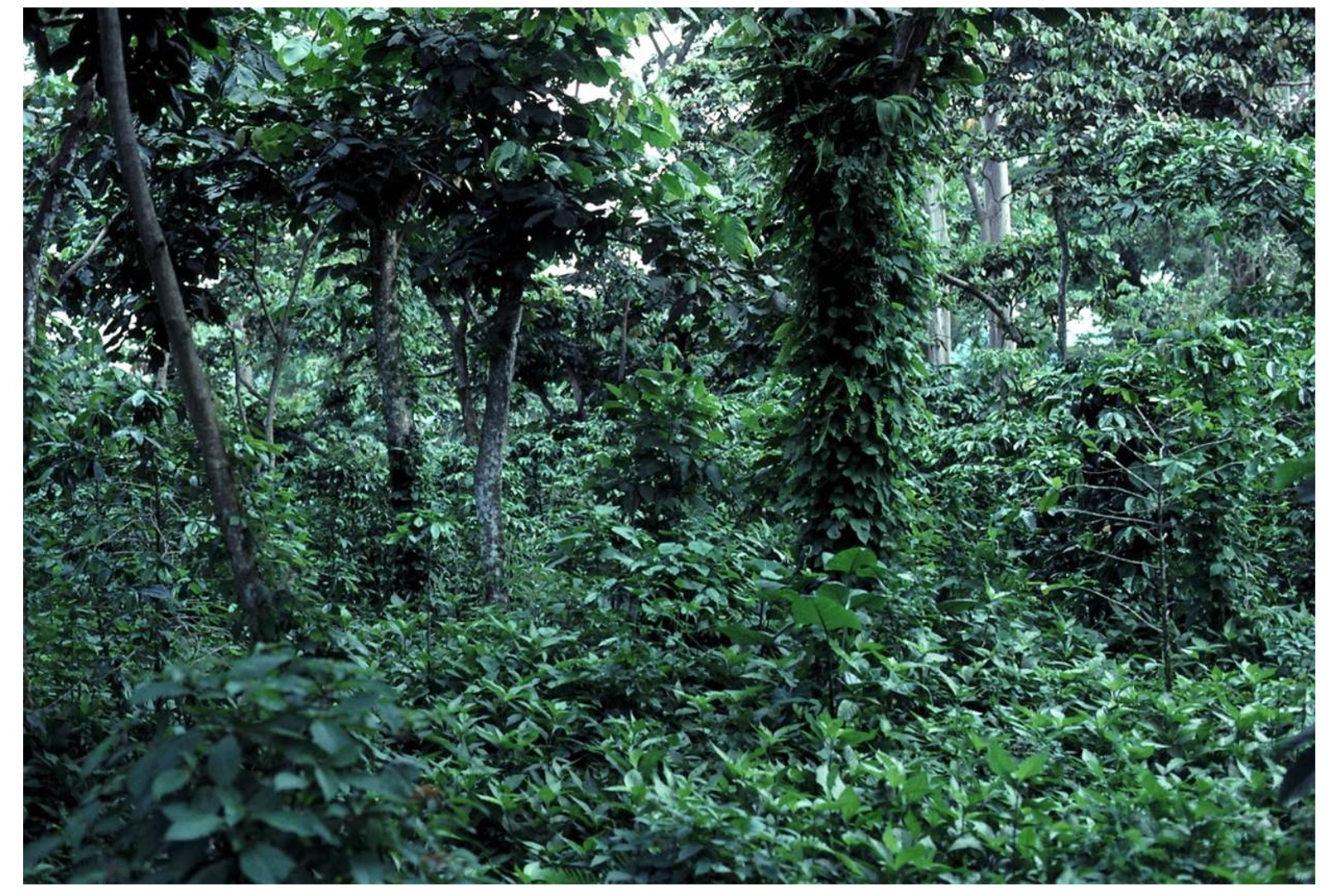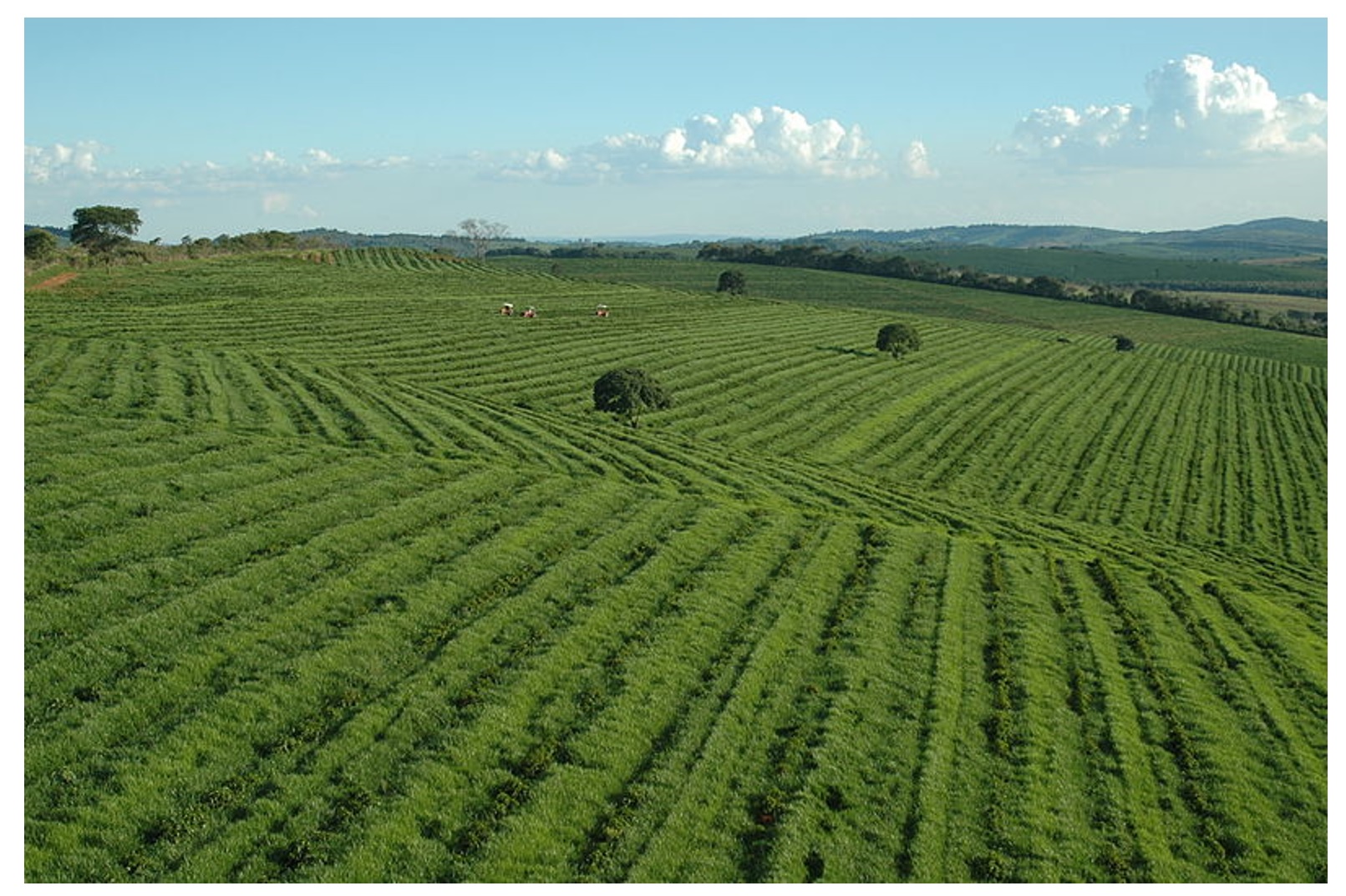18 Case Study #2 – Environment
Case study #2 – The Land is Sick
Disclaimer: This is a fictitious scenario created for the purposes of microbiome, health, disease, and environmental education. Any names, characters, places and incidents either are products of the author’s imagination or are used fictitiously. Any resemblance to actual events or locales or persons, living or dead, is entirely coincidental.
Part I – Background and Problem
Coffee production in South America has drastically decreased in the 2021-23 growing seasons. Specifically, the major farms in Columbia and Brazil which collectively contribute over half of each countries coffee (both specialty and commercial) production, have had severe crop failures. As a result, the price of a cup of coffee has noticeably increased, putting financial strain on suppliers and businesses.


Interestingly, the few years prior to this decline, coffee production was at an all-time high, with more coffee in the market than demanded. This dropped the price of coffee, and in many cases original farmers were not fairly compensated.
The International Coffee Organization (ICO) has tasked a team of researchers to identify potential problems to South American coffee plant failure and provide quick and efficient resolution.
Article 1 – The Bacterial Microbiome of Meloidogyne-Based Disease Complex in Coffee and Tomato
Video 1 – The biggest threats to the coffee industry
Video 2 – #1 Specialty coffee and the price crisis | Producer Crossover 2019
Questions:
- As a scientific researcher, what are some factors you would take into consideration when addressing this problem?
- What type of environmental microbiomes could be implicated in coffee plant crop failure and why?
- Should other coffee farms in countries besides those in South America be worried about similar failure in their crops? Why or why not?
Attributions:
- Figure 1 – Coffee exports by country 2019-20 by Dylan Parks. Data source: International Coffee Organization
- Figure 2 – A world map of countries by coffee production, 2019 by Cbahrs licensed under CC BY-SA 4.0
- Article 1 – The Bacterial Microbiome of Meloidogyne-Based Disease Complex in Coffee and Tomato by Lamelas et al., 2020 licensed under the terms of the Creative Commons Attribution License (CC BY).
- Article 2 – A review of three major fungal diseases of Coffea Arabica L. in the rainforests of Ethiopia and progress in breeding for resistance in Kenya by Hindorf and Omondi, 2011 licensed under CC BY-NC-ND 3.0
- Article 3 – Structure and Dynamics of the Gut Bacterial Community Across the Developmental Stages of the Coffee Berry Borer, Hypothenemus hampei by Mejía-Alvarado et al., 2021 licensed under the terms of the Creative Commons Attribution License (CC BY).
- Video 1 – The biggest threats to the coffee industry by Startup to Storefront licensed under a Creative Commons Attribution License (reuse allowed)
- Video 2 – #1 Specialty coffee and the price crisis | Producer Crossover 2019 by Coffee Circle licensed under a Creative Commons Attribution License (reuse allowed)
Case study #2 – The Land is Sick
Disclaimer: This is a fictitious scenario created for the purposes of microbiome, health, disease, and environmental education. Any names, characters, places and incidents either are products of the author’s imagination or are used fictitiously. Any resemblance to actual events or locales or persons, living or dead, is entirely coincidental.
Part II – Approach, Implementation, Reasoning
Upon initial inspection, the unhealthy coffee plants exhibited yellowing of leaves, appearance of red-brown lesions, abnormal shape, damaged coffee berries, and little new growth or production. Researchers decided to take samples of healthy and unhealthy leaves and berries, as well as soil and root samples.
Article 1 – Prokaryotic diversity in the rhizosphere of organic, intensive, and transitional coffee farms in Brazil
Video 1 – #2 Producer Crossover 2019
Video 2 – How countries farm and make coffee differently
Over the next year, other plantations in Columbia and Central American begin to experience similar declines in coffee plant health. Farmers were questioned about any changes in practices, and while there have been some adjustments do to the fluctuating coffee prices, traditional farming techniques have remained the same for the most part in smaller plantations. Larger plantations with intensive farming made more changes due to trader suggestions on improving yields including application of different fertilizers and hiring less experienced workers.
Questions:
- What type of analytical techniques do you think were or should be performed on the samples taken?
- How could the observed symptoms of the unhealthy plants be connected to an associated microbiome?
- How could human intervention exacerbate or ameliorate this situation?
Attributions:
- Article 1 – Prokaryotic diversity in the rhizosphere of organic, intensive, and transitional coffee farms in Brazil by Caldwell et al., 2015 licensed under a Creative Commons Attribution-ShareAlike 4.0 International (CC BY-SA 4.0) license.
- Article 2 – A metagenomics approach in the evaluation of the soil microbiome in coffee plantations under organic and conventional production in tropical agroecosystems by Rodriguez et al., 2020 licensed under a Creative Commons Attribution-NonCommercial 4.0 International License.
- Video 1 – #2 Producer Crossover 2019 by Coffee Circle licensed under a Creative Commons Attribution License (reuse allowed)
- Video 2 – How countries farm and make coffee differently by Startup to Storefront licensed under a Creative Commons Attribution License (reuse allowed)
Case study #2 – The Land is Sick
Disclaimer: This is a fictitious scenario created for the purposes of microbiome, health, disease, and environmental education. Any names, characters, places and incidents either are products of the author’s imagination or are used fictitiously. Any resemblance to actual events or locales or persons, living or dead, is entirely coincidental.
Part III – Discussion
Analysis of the negatively affected plantations’ soil showed a decline in plant growth promoting bacteria and mycorrhizae and an increase in bacterial and fungal pathogens like Pseudomonas syringae and Cercospora coffeicola.
Over the next few years (2022-24) coffee plants still struggle to grow in Central and South America. Other parts of the world, such as Vietnam and other Asian countries, are seeing a decline in crop health also, further contributing to global coffee market troubles. Many of these farms switched from shade-grown to intense sun-grown coffee to try to meet needs for demand. Larger corporations and roasters have purchased many of the smaller family farms to try to recoup losses and implement ‘new and improved’ growing strategies for increased production. This included switching to primarily sun-grown coffee, and application of large amounts of synthetic nitrogen fertilizer.

Figure 1. Shade grown coffee in Guatemala

Figure 2. Sun-grown coffee plantation in Brazil
Video 1- #3 The future of the price crisis
Video 2 – How coffee destroys the environment
Article 3 – Effects of environmental factors on microbiota of fruits and soil of Coffea arabica in Brazil
Questions:
- What factors could cause these changes in the soil microbiomes?
- Why do you think coffee plantations across the globe are beginning to fail as well?
- How does natural biodiversity benefit ecosystem health on both a micro and macro scale?
Attributions:
- Figure 1 – Shade grown coffee in Guatemala by John Blake under Public Domain
- Figure 2. Sun-grown coffee plantation in Brazil by Knase caption adapted by Dylan Parks licensed under the Creative Commons Attribution 3.0 Germany license.
- Video 1 – #3 The future of the price crisis by Coffee Circle licensed under a Creative Commons Attribution License (reuse allowed)
- Video 2 – How coffee destroys the environment by Startup to Storefront licensed under a Creative Commons Attribution License (reuse allowed)
- Article 1 – Root endophytes of coffee (Coffea Arabica): Variation across climatic gradients and relationships with functional traits by Fulthorpe et al., 2020 licensed under Creative Commons Attribution License (CC BY).
- Article 2 – Brazilian Coffee Production and the Future Microbiome and Mycotoxin Profile Considering the Climate Change Scenario by dos Santos et al., 2021 licensed under the terms and conditions of the Creative Commons Attribution (CC BY) license.
- Article 3 – Effects of environmental factors on microbiota of fruits and soil of Coffea arabica in Brazil by Veloso et al., 2020 licensed under the terms and conditions of the Creative Commons Attribution (CC BY) license.
Case study #2 – The Land is Sick
Disclaimer: This is a fictitious scenario created for the purposes of microbiome, health, disease, and environmental education. Any names, characters, places and incidents either are products of the author’s imagination or are used fictitiously. Any resemblance to actual events or locales or persons, living or dead, is entirely coincidental.
Part IV – Resolution
In 2030, most varieties of coffee are extinct, and only small amounts of coffee are produced on shade grown farms further from the equator. It appears that coffee plantations were severely impacted by increasing global temperatures, which altered ecosystem dynamics and promoted pathogen and pest invasion. Fungi, bacteria, and arthropods devastated already struggling coffee farms and with a major switch to sun-grown coffee, soil microbiomes were depleted and disease spread rapidly through monoculture crops. This switchover was prompted by an energy drink corporation, KAPOW!, which wanted to corner the caffeine market and boost production, though their expertise in growing coffee was lacking and the excessive use of synthetic fertilizers on already sun baked land which requires much more watering further doomed plantations. At least they now produce a cheap “coffee” flavored energy drink. It tastes terrible.
Article 1 – Coffee Microbiota and Its Potential Use in Sustainable Crop Management. A Review
Article 2 – Soil fungal communities differ between shaded and sun-intensive coffee plantations in El Salvador
Article 3 – One health relationships between human, animal, and environmental microbiomes: A mini-review
Video 1 – Teaching coffee farmers about the birds and the bees
Questions:
- In what ways are environmental microbiomes impacted by changing environmental factors and how can this promote diseases within an ecosystem?
- How could various environmental microbiomes be utilized to improve sustainable practices and technology?
- How are environmental and human microbiomes interconnected?
Attributions:
- Article 1 – Coffee Microbiota and Its Potential Use in Sustainable Crop Management. A Review by Duong et al., 2020 licensed under the terms of the Creative Commons Attribution License (CC BY).
- Article 2 – Soil fungal communities differ between shaded and sun-intensive coffee plantations in El Salvador by Rao et al., 2020 licensed under the Creative Commons CC0 public domain dedication.
- Article 3 – https://www.frontiersin.org/articles/10.3389/fpubh.2018.00235/full by Trinh et al., 2018 licensed under the terms of the Creative Commons Attribution License (CC BY).
- Video 1 – Teaching coffee farmers about the birds and the bees by VOA Learning English licensed under a Creative Commons Attribution License (reuse allowed)
References:
- Hindorf, H., & Omondi, C. O. (2011). A review of three major fungal diseases of Coffea arabica L. in the rainforests of Ethiopia and progress in breeding for resistance in Kenya. Journal of Advanced Research, 2(2), 109–120. https://doi.org/https://doi.org/10.1016/j.jare.2010.08.006
- Lamelas, A., Desgarennes, D., López-Lima, D., Villain, L., Alonso-Sánchez, A., Artacho, A., Latorre, A., Moya, A., & Carrión, G. (2020). The Bacterial Microbiome of Meloidogyne-Based Disease Complex in Coffee and Tomato. Frontiers in Plant Science, 11. https://www.frontiersin.org/article/10.3389/fpls.2020.00136
- Duong, B., Marraccini, P., Maeght, J.-L., Vaast, P., Lebrun, M., & Duponnois, R. (2020). Coffee Microbiota and Its Potential Use in Sustainable Crop Management. A Review. Frontiers in Sustainable Food Systems, 4. https://www.frontiersin.org/article/10.3389/fsufs.2020.607935
- Fulthorpe, R., Martin, A. R., & Isaac, M. E. (2019). Root Endophytes of Coffee (Coffea arabica): Variation Across Climatic Gradients and Relationships with Functional Traits. Phytobiomes Journal, 4(1), 27–39. https://doi.org/10.1094/PBIOMES-04-19-0021-R
- dos Santos DG, Coelho CCdS, Ferreira ABR, Freitas-Silva O. Brazilian Coffee Production and the Future Microbiome and Mycotoxin Profile Considering the Climate Change Scenario. Microorganisms. 2021; 9(4):858. https://doi.org/10.3390/microorganisms9040858
- Caldwell AC, Silva LCF, da Silva CC, Ouverney CC (2015) Prokaryotic Diversity in the Rhizosphere of Organic, Intensive, and Transitional Coffee Farms in Brazil. PLoS ONE 10(6): e0106355. doi:10.1371/journal.pone.0106355
- Rodríguez, A. C.-, R. T.- Calzada, C. G.-D. la Peña, J. G. A.- Ávila, E. N.- Reyna, F. V.- Paniagua, C. D.- Velásquez, and C. A. M.- Herrera. “A Metagenomic Approach in the Evaluation of the Soil Microbiome in Coffee Plantations under Organic and Conventional Production in Tropical Agroecosystems”. Emirates Journal of Food and Agriculture, Vol. 32, no. 4, Apr. 2020, pp. 263-70, https://doi.org/10.9755/ejfa.2020.v32.i4.2092.
- Rao, M., Rice, R., Fleischer, R., & Muletz Wolz, C. (2020). Soil fungal communities differ between shaded and sun-intensive coffee plantations in El Salvador. PLOS ONE, 15, e0231875. https://doi.org/10.1371/journal.pone.0231875
- Mejía-Alvarado, F. S., Ghneim-Herrera, T., Góngora, C. E., Benavides, P., & Navarro-Escalante, L. (2021). Structure and Dynamics of the Gut Bacterial Community Across the Developmental Stages of the Coffee Berry Borer, Hypothenemus hampei. Frontiers in Microbiology, 12. https://www.frontiersin.org/article/10.3389/fmicb.2021.639868
- Veloso, T. G. R., da Silva, M. de C. S., Cardoso, W. S., Guarçoni, R. C., Kasuya, M. C. M., & Pereira, L. L. (2020). Effects of environmental factors on microbiota of fruits and soil of Coffea arabica in Brazil. Scientific Reports, 10(1), 14692. https://doi.org/10.1038/s41598-020-71309-y
- Trinh, P., Zaneveld, J. R., Safranek, S., & Rabinowitz, P. M. (2018). One Health Relationships Between Human, Animal, and Environmental Microbiomes: A Mini-Review. Frontiers in Public Health, 6. https://www.frontiersin.org/article/10.3389/fpubh.2018.00235

